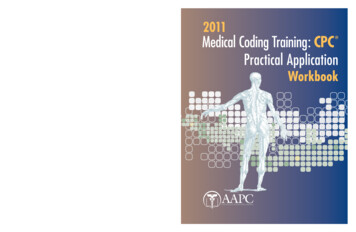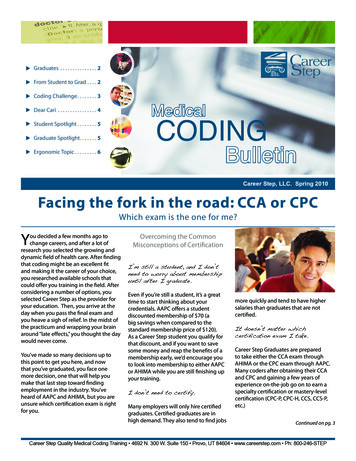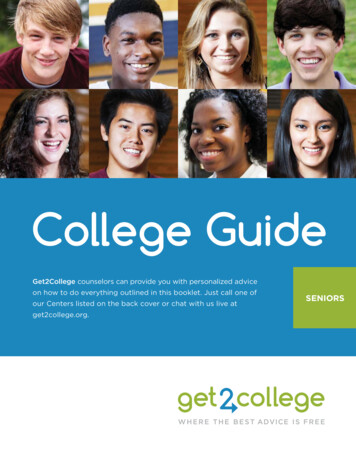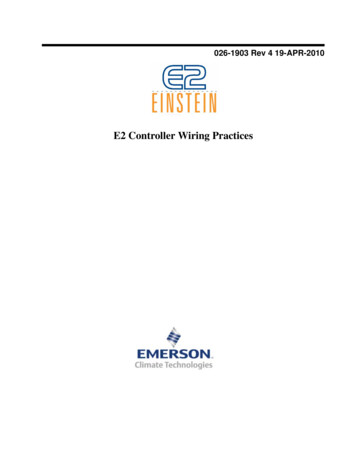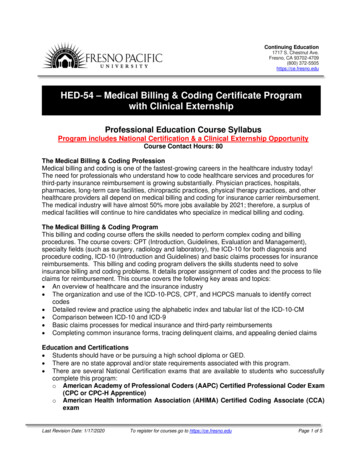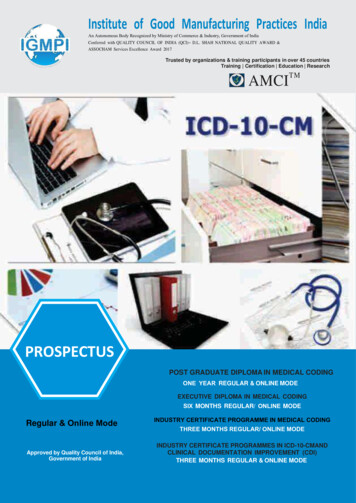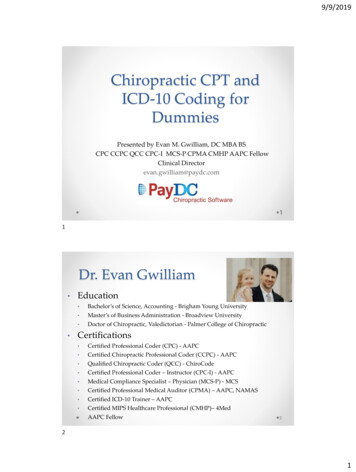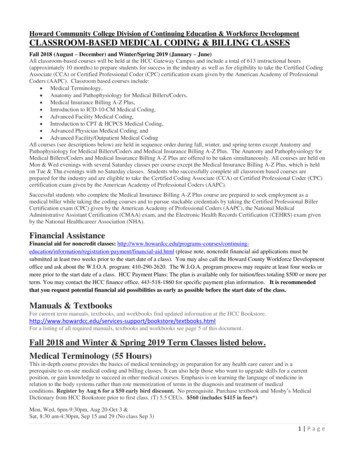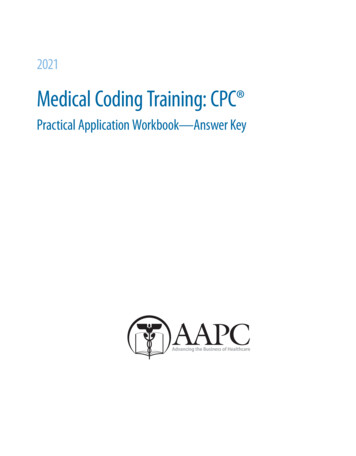
Transcription
2021Medical Coding Training: CPC Practical Application Workbook—Answer Key
DisclaimerThis course was current when it was published. Every reasonable effort has been made to assure the accuracy of the informationwithin these pages. The ultimate responsibility lies with readers to ensure they are using the codes, and following applicableguidelines, correctly. AAPC employees, agents, and staff make no representation, warranty, or guarantee that this compilation ofinformation is error-free, and will bear no responsibility or liability for the results or consequences of the use of this course. Thisguide is a general summary that explains guidelines and principles in profitable, efficient healthcare organizations.US Government RightsThis product includes CPT , which is commercial technical data and/or computer data bases and/or commercial computersoftware and/or commercial computer software documentation, as applicable, which was developed exclusively at private expenseby the American Medical Association, 515 North State Street, Chicago, Illinois, 60610. U.S. Government rights to use, modify,reproduce, release, perform, display, or disclose these technical data and/or computer data bases and/or computer software and/or computer software documentation are subject to the limited rights restrictions of DFARS 252.227-7015(b)(2) (November 1995),as applicable, for U.S. Department of Defense procurements and the limited rights restrictions of FAR 52.227-14 (June 1987) and/or subject to the restricted rights provision of FAR 52.227-14 (June 1987) and FAR 52.227-19 (June 1987), as applicable, and anyapplicable agency FAR Supplements, for non-Department of Defense Federal procurements.AMA DisclaimerCPT copyright 2020 American Medical Association. All rights reserved.Fee schedules, relative value units, conversion factors and/or related components are not assigned by the AMA, are not part ofCPT , and the AMA is not recommendation their use. The AMA does not directly or indirectly practice medicine or dispensemedical services. The AMA assumes no liability for data contained or not contained herein.CPT is a registered trademark of the American Medical Association.Regarding HCPCS Level IIHCPCS Level II codes and guidelines discussed in this book are current as of press time. The 2021 code set for HCPCS Level IIwere unavailable when published.Clinical Examples Used in this BookAAPC believes it is important in training and testing to reflect as accurate a coding setting as possible to students and examinees.All examples and case studies used in our study guides, exams, and workbooks are actual, redacted office visit and procedurenotes donated by AAPC members.To preserve the real-world quality of these notes for educational purposes, we have not re-written or edited the notes to thestringent grammatical or stylistic standards found in the text of our products. Some minor changes have been made for clarity orto correct spelling errors originally in the notes, but essentially, they are as one would find them in a coding setting. 2020 AAPC2233 South Presidents Dr. Suites F-C, Salt Lake City, UT 84120800-626-2633, Fax 801-236-2258, www.aapc.comUpdated 10072020. All rights reserved.ISBN 978-1-646310-524CPC , CIC , COC , CPC-P , CPMA , CPCO , and CPPM are trademarks of AAPC.ii2021 Medical Coding Training: CPC Practical Application Workbook—Answer KeyCPT copyright 2020 American Medical Association. All rights reserved.
ContentsChapter 1The Business of Medicine . . . . . . . . . . . . . . . . . . . . . . . . . . . . . . . . . . . . . . . . . . . . . . . . . . . . . . . . . . . . . . . . . . . . . . . . . . . . 1Chapter 2Medical Terminology and Anatomy Review . . . . . . . . . . . . . . . . . . . . . . . . . . . . . . . . . . . . . . . . . . . . . . . . . . . . . . . . . . . . . 5Chapter 3Introduction to ICD-10-CM . . . . . . . . . . . . . . . . . . . . . . . . . . . . . . . . . . . . . . . . . . . . . . . . . . . . . . . . . . . . . . . . . . . . . . . . . . . 7Chapter 4ICD-10-CM Coding Chapters 1–11 . . . . . . . . . . . . . . . . . . . . . . . . . . . . . . . . . . . . . . . . . . . . . . . . . . . . . . . . . . . . . . . . . . . . 11Chapter 5ICD-10-CM Coding Chapters 12–21 . . . . . . . . . . . . . . . . . . . . . . . . . . . . . . . . . . . . . . . . . . . . . . . . . . . . . . . . . . . . . . . . . . . 19Chapter 6Introduction to CPT , Surgery Guidelines, HCPCS Level II, and Modifiers . . . . . . . . . . . . . . . . . . . . . . . . . . . . . . . . . . . . 29Chapter 7Integumentary System . . . . . . . . . . . . . . . . . . . . . . . . . . . . . . . . . . . . . . . . . . . . . . . . . . . . . . . . . . . . . . . . . . . . . . . . . . . . . 33Chapter 8Musculoskeletal System . . . . . . . . . . . . . . . . . . . . . . . . . . . . . . . . . . . . . . . . . . . . . . . . . . . . . . . . . . . . . . . . . . . . . . . . . . . . 45Chapter 9Respiratory, Hemic, Lymphatic, Mediastinum, and Diaphragm . . . . . . . . . . . . . . . . . . . . . . . . . . . . . . . . . . . . . . . . . . . . 57Chapter 10Cardiovascular System . . . . . . . . . . . . . . . . . . . . . . . . . . . . . . . . . . . . . . . . . . . . . . . . . . . . . . . . . . . . . . . . . . . . . . . . . . . . . 67Chapter 11Digestive System . . . . . . . . . . . . . . . . . . . . . . . . . . . . . . . . . . . . . . . . . . . . . . . . . . . . . . . . . . . . . . . . . . . . . . . . . . . . . . . . . . 81Chapter 12Urinary System and Male Genital System . . . . . . . . . . . . . . . . . . . . . . . . . . . . . . . . . . . . . . . . . . . . . . . . . . . . . . . . . . . . . 93CPT copyright 2020 American Medical Association. All rights reserved.www.aapc.comiii
ContentsChapter 13Female Reproductive System . . . . . . . . . . . . . . . . . . . . . . . . . . . . . . . . . . . . . . . . . . . . . . . . . . . . . . . . . . . . . . . . . . . . . . . 105Chapter 14Endocrine and Nervous System . . . . . . . . . . . . . . . . . . . . . . . . . . . . . . . . . . . . . . . . . . . . . . . . . . . . . . . . . . . . . . . . . . . . . 117Chapter 15Eye and Ocular Adnexa, Auditory Systems . . . . . . . . . . . . . . . . . . . . . . . . . . . . . . . . . . . . . . . . . . . . . . . . . . . . . . . . . . . . 131Chapter 16Anesthesia . . . . . . . . . . . . . . . . . . . . . . . . . . . . . . . . . . . . . . . . . . . . . . . . . . . . . . . . . . . . . . . . . . . . . . . . . . . . . . . . . . . . . . 143Chapter 17Radiology . . . . . . . . . . . . . . . . . . . . . . . . . . . . . . . . . . . . . . . . . . . . . . . . . . . . . . . . . . . . . . . . . . . . . . . . . . . . . . . . . . . . . . . 155Chapter 18Pathology and Laboratory . . . . . . . . . . . . . . . . . . . . . . . . . . . . . . . . . . . . . . . . . . . . . . . . . . . . . . . . . . . . . . . . . . . . . . . . . 169Chapter 19Evaluation and Management . . . . . . . . . . . . . . . . . . . . . . . . . . . . . . . . . . . . . . . . . . . . . . . . . . . . . . . . . . . . . . . . . . . . . . . 181Chapter 20Medicine . . . . . . . . . . . . . . . . . . . . . . . . . . . . . . . . . . . . . . . . . . . . . . . . . . . . . . . . . . . . . . . . . . . . . . . . . . . . . . . . . . . . . . . . 201iv2021 Medical Coding Training: CPC Practical Application Workbook—Answer KeyCPT copyright 2020 American Medical Association. All rights reserved.
Chapter1The Business of MedicineExercise 11.What type of profession, other than coding, might a skilled coder enter?Answer: Consultants, educators, medical auditors2.What is the difference between outpatient and inpatient coding?Answer: Outpatient coders focus on assigning CPT , HCPCS Level II, and ICD-10-CM codes. They work in provideroffices, outpatient clinics and facility outpatient departments. Outpatient facility coders also work with ambulatorypayment classifications (APCs).Inpatient hospital coding focuses on a different subset of skills, where coders work with ICD-10-CM and ICD-10-PCS.These coders also assign Medicare severity-diagnosis related groups (MS-DRGs) for reimbursement. Outpatient codersusually have more interaction throughout the day and must communicate well with providers; inpatient coders tend tohave less interaction throughout the day.3.What is a mid-level provider?Answer: Mid-level providers include physician assistants (PA) and nurse practitioners (NP). Mid-level providers are knownalso as physician extenders because they extend the work of a physician.4.Discuss the different parts of Medicare and what each program covers.Answer:llllMedicare Part A helps to cover inpatient hospital care, as well as care provided in skilled nursing facilities, hospicecare, and home healthcare.Medicare Part B covers two types of services: 1) Medically necessary provider services that are needed to diagnose ortreat a medical condition and that meet accepted standards of medical practice; and 2) preventive services to preventillness or detect it at an early stage. Medicare Part B is an optional benefit for which the patient pays a premium, anannual deductible and generally has a 20% co-insurance except for preventive services covered under healthcare law.Coders working in provider offices code mainly Medicare Part B claims.Medicare Part C, also called Medicare Advantage, combines the benefits of Medicare Part A, Part B and sometimesPart D. The plans are managed by private insurers approved by Medicare and may include preferred providerorganizations, health maintenance organizations, etc.Medicare Part D is a prescription drug coverage program available to all Medicare beneficiaries for a fee. Privatecompanies approved by Medicare provide the coverage.CPT copyright 2020 American Medical Association. All rights reserved.www.aapc.com1
The Business of Medicine5.Chapter 1Evaluation and management (E/M) services are often provided in a standard format. One such format is SOAP notes.What does SOAP represent?Answer:S—Subjective — The patient’s statement about his or her health, including symptoms.O— Objective — The provider assesses and documents the patient’s illness using observation, palpation, auscultation, andpercussion. Tests and other performed services may be documented here as well.A— Assessment — Evaluation and conclusion made by the provider. This is usually where the diagnosis(es) for the servicesare found.P— Plan — Course of action. Here, the provider will list the next steps for the patient, whether ordering additional tests,taking over the counter medications, etc.6.What are five tips for coding operative (OP) reports?Answer:7.1.Diagnosis code reporting — Use the post-operative diagnosis for coding unless there are further defined diagnoses oradditional diagnoses found in the body or op report findings. If a pathology report is available, use the findings fromthe pathology report for the diagnosis.2.Start with the procedures listed — One way to start the research process quickly is by focusing on the procedureslisted in the header. Read the note in its entirety to verify the procedures performed. Procedures listed in the headermay not be listed correctly and procedures documented within the body of the report may not be listed in the headerat all; however, it is a place to start.3.Look for key words — Key words may include locations and involved anatomical structures, surgical approach, procedure method (debridement, drainage, incision, repair, etc.), procedure type (open, closed, simple, intermediate, etc.),size and number, and the surgical instruments used during the procedure.4.Highlight unfamiliar words — Research for understanding.5.Read the body — All reported procedures should be documented within the body of the report. The report’s bodymay indicate a procedure was abandoned or complicated, possibly indicating the need for a different procedure codeor reporting of a modifier.What is medical necessity and what tool can you refer to for the medical necessity of a service?Answer: The term medical necessity relates to whether a procedure or service is considered appropriate in a given circumstance. Tools to determine medical necessity include national coverage determinations (NCDs), local coverage determinations (LCDs), and commercial payer policies.8.What are common reasons Medicare may deny a procedure or service?Answer:lll2Medicare doesn’t pay for the procedure/service to treat the patient’s condition.Medicare doesn’t pay for the procedure/service as frequently as proposed.Medicare doesn’t pay for experimental procedures/services.2021 Medical Coding Training: CPC Practical Application Workbook—Answer KeyCPT copyright 2020 American Medical Association. All rights reserved.
Chapter 19.The Business of MedicineUnder the Privacy Rule, the minimum necessary standard does NOT apply to what type of disclosures?Answer:llllllDisclosures to or requests by a healthcare provider for treatment purposes.Disclosures to the individual who is the subject of the information.Uses or disclosures made pursuant to an individual’s authorization.Uses or disclosures required for compliance with the HIPAA Administrative Simplification Rules.Disclosures to the U.S. Department of Health & Human Services (HHS) when disclosure of information is requiredunder the Privacy Rule for enforcement purposes.Uses or disclosures required by other law.10. What are seven key components of an internal compliance plan?Answer:lllllllConducting internal monitoring and auditing through the performance of periodic audits.Implementing compliance and practice standards through the development of written standards and procedures.Designating a compliance officer or contact(s) to monitor compliance efforts and enforce practice standards.Conducting appropriate training and education on practice standards and procedures.Responding appropriately to detected violations through the investigation of allegations and the disclosure ofincidents to appropriate government entities.Developing open lines of communication, such as (1) discussions at staff meetings regarding how to avoid erroneousor fraudulent conduct; and (2) community bulletin boards to keep practice employees updated regarding complianceactivities.Enforcing disciplinary standards through well-publicized guidelines.CPT copyright 2020 American Medical Association. All rights reserved.www.aapc.com3
Chapter21.Medical Terminology and Anatomy ReviewDiagnosis: Calcification left basal gangliaWhere are the basal ganglia located?Answer: Cerebral Cortex2.Diagnosis: Vesicoureteral refluxWhat is this a reflux of?Answer: Urine backflow from bladder into ureters3.Documentation: The posterior vaginal fornix and outer cervical os were prepped with a cleansing solution.In this statement, what does “os” stand for?Answer: Ostium (opening)4.Hysterosalpingogram report: “Right cornual contour abnormality.”Where is the cornua found anatomically for this case?Answer: The cornua are where the fallopian tube connect to the uterine fundus.5.Surgical procedure: MyringotomyWhat anatomic location is being operated on?Answer: Ear6.Documentation: There was no cleft of the uvula or submucosal palate by visual and palpable exam.What is being examined?Answer: Oral cavity7.Documentation: Recession of left inferior rectus muscle, 5 mmWhat anatomic location is being operated on?Answer: Eye8.Diagnosis: KyphosisWhat anatomic location does this diagnosis most often refer to?Answer: Thoracic SpineCPT copyright 2020 American Medical Association. All rights reserved.www.aapc.com5
Medical Terminology and Anatomy Review9.Chapter 2Documentation: Suprapatellar recess showed no evidence of loose bodies or joint pathology.What anatomic location does this refer to?Answer: Knee (above the patella)10. Colles’ fractureWhat anatomic location does this refer to?Answer: Wrist62021 Medical Coding Training: CPC Practical Application Workbook—Answer KeyCPT copyright 2020 American Medical Association. All rights reserved.
Chapter3Introduction to ICD-10-CMExercise 1Directions: Using the ICD-10-CM code book locate the diagnosis codes for the following conditions.1.FeverAnswer: R50.9Rationale: In the ICD-10-CM Alphabetic Index, look for Fever. There is no additional information provided. The defaultcode is R50.9. Review the code in the Tabular List to verify the code accuracy.2.Chronic non-intractable common migraine headache with status migrainosusAnswer: G43.701Rationale: Determine the main term which is headache. In the ICD-10-CM Alphabetic Index, look for Headache/migraine(type) (see also Migraine). In the same index, Migraine (idiopathic)/common directs you to see Migraine, without aura.Migraine/without aura/chronic/not intractable/with status migrainosus directs you to code G43.701. Review the code inthe Tabular List to verify the code accuracy.3.Otitis media left earAnswer: H66.92Rationale: The main term is otitis. In the ICD-10-CM Alphabetic Index, look for Otitis/media. There is no additional information provided. You are referred to H66.9-. The dash indicates an additional character is required for a complete code.Review the code in the Tabular List for the 5th character. Under subcategory H66.9 you will see Otitis Media NOS listed.The 5th character is 2 indicating the infection is in the left ear. This is an infection of the middle ear (media).4.Epigastric painAnswer: R10.13Rationale: The main term is pain. In the ICD-10-CM Alphabetic Index, look for Pain/epigastric, epigastrium. You arereferred to R10.13. Review the code in the Tabular List to verify the code accuracy.5.Acute asthma exacerbationAnswer: J45.901Rationale: The main term is asthma. In the ICD-10-CM Alphabetic Index, look for Asthma, asthmatic/with/exacerbation(acute) J45.901. Review the code in the Tabular List to verify the code accuracy. Note: There is a category note for J45 to useadditional code to identify exposure to, use of, or dependence of tobacco. This is coded if known.CPT copyright 2020 American Medical Association. All rights reserved.www.aapc.com7
Introduction to ICD-10-CM6.Chapter 3Acute myocardial infarctionAnswer: I21.9Rationale: The main term is infarction. In the ICD-10-CM Alphabetic Index, look for Infarct, infarction/myocardium,myocardial (acute) (with stated duration of 4 weeks or less) I21.9. Refer to the Tabular List. This is the correct code, eventhough there is no stated duration in the question, because code I21.9 lists Myocardial infarction (acute) NOS under thecode. Note: There is a category note for I21 to use additional code, if applicable, to identify exposure to, use of, dependenceof tobacco, or status post tPA in another facility. This is coded if known.7.Hypertensive heart diseaseAnswer: I11.9Rationale: : The main term is disease. In the ICD-10-CM Alphabetic Index, look for Disease, diseased/heart (organic)/hypertensive and you are directed to see Hypertension, heart. Hypertension, hypertensive/heart directs you to I11.9.Review the code in the Tabular List to verify the code accuracy. Note: There is a category note for I10-I15 to use additionalcode to identify exposure to, use of, or dependence of tobacco. This is coded if known.8.SyncopeAnswer: R55Rationale: Look for Syncope in the ICD-10-CM Alphabetic Index. You are referred to R55. Review the code in the TabularList to verify the code accuracy.9.Nausea and vomitingAnswer: R11.2Rationale: Nausea and vomiting are both main terms. In the ICD-10-CM Alphabetic Index, look for Nausea/with vomitingor Vomiting/with nausea. You are referred to R11.2. Review the code in the Tabular List to verify the code accuracy.10. GERDAnswer: K21.9Rationale: GERD is an acronym for gastroesophageal reflux disease. The main term is disease. This diagnosis can belocated in the index under the acronym or the main term. In the ICD-10-CM Alphabetic Index, look for GERD (gastroesophageal reflux disease) or look for Disease/gastroesophageal reflux (GERD). You are referred to K21.9. Review the codein the Tabular List to verify the code accuracy.11. Chlamydial inflammation of the testesAnswer: A56.19Rationale: Inflammation and chlamydia are both main terms. In the ICD-10-CM Alphabetic Index, look for Inflammation, inflamed, inflammatory/testes, which directs you to see Orchitis. Orchitis is the inflammation of the testes. Look forOrchitis/chlamydial or Chlamydia, chlamydial/orchitis. You are referred to A56.19. Review the code in the Tabular List toverify the code accuracy. Under code A56.19, chlamydial orchitis is listed.82021 Medical Coding Training: CPC Practical Application Workbook—Answer KeyCPT copyright 2020 American Medical Association. All rights reserved.
Chapter 3Introduction to ICD-10-CM12. Sickle-cell anemiaAnswer: D57.1Rationale: The main term is anemia. In the ICD-10-CM Alphabetic Index, look for Anemia/sickle-cell – see Disease,sickle-cell. Disease, diseased/sickle cell directs you to D57.1. Review the code in the Tabular List to verify the code accuracy. Sickle-cell anemia NOS is listed as an inclusion term under D57.1. Note: There is a category note under D57 to use anadditional code for any associated fever. This is coded if known.13. Ruptured spleen (not due to an injury)Answer: D73.5Rationale: The main term is ruptured. From the ICD-10-CM Alphabetic Index look for Rupture, ruptured/spleen/nontraumatic. You are referred to D73.5. Review the code in the Tabular List to verify the code accuracy. The diagnosis documentsthe rupture of the spleen was not due an injury, also called nontraumatic. Splenic rupture, nontraumatic is listed as aninclusion term under D73.5.14. Cellulitis of the armAnswer: L03.119Rationale: The main term is cellulitis. In the ICD-10-CM Alphabetic Index, look for Cellulitis/arm – see Cellulitis, upperlimb. Look for Cellulitis/upper limb and you are referred to L03.11-. The dash indicates another character is required for acomplete code. Review the code in the Tabular List to report the 6th character and verify the code accuracy. The diagnosisdoes not specify if the cellulitis is in the left or right arm, so report L03.119.15. Chest massAnswer: R22.2Rationale: The main term is mass. In the ICD-10-CM Alphabetic Index, look for Mass/chest. You are referred to R22.2.Review the code in the Tabular List to verify the code accuracy.16. Novel H1N1 fluAnswer: J10.1Rationale: The main term is flu. In the ICD-10-CM Alphabetic Index, look for Flu there are no subentries for Novel orH1N1. It does instruct you to see also Influenza. Look for Influenza/novel (2009) H1N1 influenza. You are referred to J10.1.Review the code in the Tabular List to verify the code accuracy. There is a use additional code note for associated pleuraleffusion or sinusitis, if applicable.17. Uncontrolled diabetes with diabetic cataractsAnswer: E11.36Rationale: The main term is diabetes. In the ICD-10-CM Alphabetic Index, look for Diabetes, diabetic/with/cataract. Youare referred to E11.36. Review the code in the Tabular List to verify the code accuracy. The term uncontrolled is not a factorin code selection for diabetes under ICD-10-CM. There is a note to use an additional code under category E11 to identify ifthe diabetes is controlled with insulin, oral antidiabetic drugs, or oral hypoglycemic drugs if known.CPT copyright 2020 American Medical Association. All rights reserved.www.aapc.com9
Introduction to ICD-10-CMChapter 318. Left, outer cheek abrasion, initial encounterAnswer: S00.81XARationale: The main term is abrasion. In the ICD-10-CM Alphabetic Index, look for Abrasion/cheek. You are referred toS00.81-. Review the code in the Tabular List to assign the 7th character and to verify the code accuracy. Because this codeneeds seven characters, the letter X is used as a placeholder for the 6th character, and the 7th character A is reported becausethe injury is an initial encounter.19. Acute cholecystitis with chronic cholecystitisAnswer: K81.2Rationale: The main term is cholecystitis. In the ICD-10-CM Alphabetic Index, look for Cholecystitis/acute/with/chroniccholecystitis. You are referred to K81.2. Review the code in the Tabular List to verify the code accuracy. Two codes are notreported for the acute and chronic cholecystitis because there is a combination code that fully identifies all the elementsdocumented in the diagnosis.20. Right eyebrow laceration, subsequent encounterAnswer: S01.111DRationale: The main term is laceration. In the ICD-10-CM Alphabetic Index, look for Laceration/eyebrow and you aredirected to see Laceration, eyelid. Look for Laceration/eyelid, and you are referred to S01.11-. Review the code in theTabular List to report 6th and 7th characters and to verify the code accuracy. S01.111D is the correct code to report becausethe laceration is on the right side. The 7th character D is reported to indicate subsequent encounter.102021 Medical Coding Training: CPC Practical Application Workbook—Answer KeyCPT copyright 2020 American Medical Association. All rights reserved.
Chapter4ICD-10-CM Coding Chapters 1–11Case 1Progress NoteThis patient is a 50-year-old female who began developing bleeding, bright red blood per rectum 1 , approximately two weeks ago.She is referred by her family physician. She states that after a bowel movement she noticed blood in the toilet. She denied any priorhistory of bleeding or pain with defecation. She states that she has had an external hemorrhoid 2 that did bleed at times but that isnot where this bleeding is coming from. She is presently concerned because a close friend of hers was recently diagnosed with rectalcarcinoma requiring chemotherapy that was missed by her primary doctor. She is here today for evaluation for a colonoscopy.Physical examination, she appears to be a well appearing 50-year-old, white female. Abdomen is soft, non-tender, non-distended.Assessment: 50-year-old female with rectal bleeding 3 .Plan: We’ll schedule the patient for an outpatient colonoscopy. The patient was made aware of all the risks involved with theprocedure and was willing to proceed. 1 Patient’s presenting complaint. 2 This is reported by the patient, but not documented in the exam or assessment, so it is not coded. 3 Report the code documented in the assessment.What diagnosis code(s) are reported?ICD-10-CM Code: K62.5Rationale: In the ICD-10-CM Alphabetic Index, look for Bleeding/rectum, rectal. You are referred to K62.5. Verify the codein the Tabular List.Case 2Preoperative Diagnosis: Bilateral profound sensorineural hearing loss.Postoperative Diagnosis: Bilateral profound sensorineural hearing loss. 1 Procedures Performed:1. Placement of left Nucleus cochlear implant.2. Facial nerve monitoring for an hour.3. Microscope use.Anesthesia: General.Indications: This is a 69-year-old woman who has had progressive hearing loss 2 over the last 10–15 years. Hearing aids are notuseful for her. She is a candidate for cochlear implant by FDA standards. The risks, benefits, and alternatives of procedure weredescribed to the patient, who voiced understanding and wished to proceed.Procedure: After properly identifying the patient, she was taken to the main operating room, where general anesthetic wasinduced. The table was turned to 180 degrees and a standard left-sided post auricular shave and injection of 1% lidocaine plusCPT copyright 2020 American Medical Association. All rights reserved.www.aapc.com11
ICD-10-CM Coding Chapters 1–11Chapter 41:100,000 epinephrine was performed. The patient was then prepped and draped in a sterile fashion after placing facial nerve monitoring probes, which were tested and found to work well. At this time, the previously outlined incision line was incised and flapswere elevated. A subtemporal pocket was designed in the usual fashion for placement of the device. A standard cortical mastoidectomy was then performed and the fascial recess was opened exposing the area of the round window niche. The lip of the roundwindow was drilled down exposing the round window membrane. At this time, the wound was copiously irrigated with Bacitracincontaining solution, and the device was then placed into the pocket. A 1 mm cochleostomy was made, and the device was insertedinto the cochleostomy with an advance off stylet technique. A small piece of temporalis muscle was packed around the cochleostomy, and the wound was closed in layers using 3-0 and 4–0 Monocryl and Steri-Strips. A standard mastoid dressing was applied.The patient was returned to anesthesia, where she was awakened, extubated, and taken to the recovery room in stable condition. 1 Report the postoperative diagnosis. 2 The diagnosis is documented as the indication for the surgery.What diagnosis c
Medical Coding Training: CPC Practical Application Workbook—Answer Key ii 2021 Medical Coding Training: CPC Practical Application Workbook—Answer Key CPT copyright 2020 American Medical Association.
